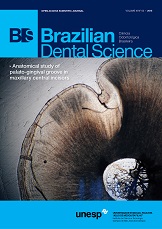Flexural strength of composites: effects of the activation techniques and fiber reinforcement.
DOI:
https://doi.org/10.14295/bds.2015.v18i3.1128Resumo
Objective: To evaluate the flexural strength of direct (Charisma) and indirect (Solidex) composites, with or without fiber reinforcements (Ribbond), cured with LED or Stroboscopic Xenon Light.MaterialandMethods: Resin bars made with or without fiber reinforcements, with 25mm x 2mm x 2mm were distributed in groups (n=10): GDL– Direct Resin/LED; GDX–Direct Resin/Stroboscopic Xenon; GDFL– Direct Resin/Fiber/LED; GDFX– Direct Resin/Fiber/Stroboscopic Xenon; GIL– Indirect Resin/LED; GIX– Indirect Resin/Stroboscopic Xenon; GIFL– Indirect Resin/Fiber/LED; GIFX– Indirect Resin/Fiber/Stroboscopic Xenon. The specimens were connected to a universal test machine and submitted to a compression load (2 kN).Results: The obtained results were submitted to Analysis of Variance tests (p < 0.01), and Tukey (5% significance level) tests. The flexural strength of groups that used polyethylene fiber reinforcement (96.39) was similar (p = 0.58) to group without fiber reinforcement (92.47). Direct composites (107.79) showed higher values of flexural strength than indirect composites (81.07), and stroboscopic xenon light curing (108.71) resulted in better flexural strength results than LED (80.15), for both kinds of composites experimented. Conclusion: The fiber reinforcement did not improve the composites’ flexural strength, direct composites showed higher flexural strength values, and stroboscopic xenon light showed better flexural strength results.
Keywords
Composite resins; Curing Lights; Fiber reinforcements; Physical properties.
Downloads
Downloads
Arquivos adicionais
Publicado
Como Citar
Edição
Seção
Licença
TRANSFERÊNCIA DE DIREITOS AUTORAIS E DECLARAÇÃO DE RESPONSABILIDADE
Toda a propriedade de direitos autorais do artigo "____________________________________________________________________" é transferido do autor(es) para a CIÊNCIA ODONTOLÓGICA BRASILEIRA, no caso do trabalho ser publicado. O artigo não foi publicado em outro lugar e não foi submetido simultaneamente para publicação em outra revista.
Vimos por meio deste, atestar que trabalho é original e não apresenta dados manipulados, fraude ou plágio. Fizemos contribuição científica significativa para o estudo e estamos cientes dos dados apresentados e de acordo com a versão final do artigo. Assumimos total responsabilidade pelos aspectos éticos do estudo.
Este texto deve ser impresso e assinado por todos os autores. A versão digitalizada deverá ser apresentada como arquivo suplementar durante o processo de submissão.




























